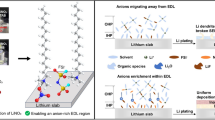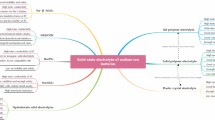Abstract
Using stable inorganic solid electrolyte to replace organic liquid electrolyte could significantly reduce potential safety risks of rechargeable batteries. Na-superionic conductor (NASICON)-structured solid electrolyte is one of the most promising sodium solid electrolytes and can be employed in solid-state sodium batteries. In this work, a NASICON-structured solid electrolyte Na3.1Zr1.95Mg0.05Si2PO12 was synthesized through a facile solid-state reaction, yielding high sodium-ionic conductivity of 1.33 × 10−3 S·cm−1 at room temperature. The results indicate that Mg2+ is a suitable and economical substitution ion to replace Zr4+, and this synthesis route can be scaled up for powder preparation with low cost. In addition to electrolyte material preparation, solid-state batteries with Na3.1Zr1.95Mg0.05Si2PO12 as electrolyte were assembled. A specific capacity of 57.9 mAh·g−1 is maintained after 100 cycles under a current density of 0.5C rate at room temperature. The favorable cycling performance of the solid-state battery suggests that Na3.1Zr1.95Mg0.05Si2PO12 is an ideal electrolyte candidate for solid-state sodium batteries.









Similar content being viewed by others
References
Goodenough JB, Kim Y. Challenges for rechargeable Li batteries. Chem Mater. 2009;22(3):587.
Kim Y, Kim H, Park S, Seo I, Kim Y. Na ion-conducting ceramic as solid electrolyte for rechargeable seawater batteries. Electrochim Acta. 2016;191:1.
Zhao C, Lu Y, Li Y, Jiang L, Rong X, Hu YS, Li H, Chen L. Novel methods for sodium-ion battery materials. Small Methods. 2017;1(5):1600063.
Palomares V, Serras P, Villaluenga I, Hueso KB, Carretero-Gonzalez J, Rojo T. Na-ion batteries, recent advances and present challenges to become low cost energy storage systems. Energ Environ Sci. 2012;5(3):5884.
Hueso KB, Armand M, Rojo T. High temperature sodium batteries: status, challenges and future trends. Energ Environ Sci. 2013;6(3):734.
Song S, Duong HM, Korsunsky AM, Hu N, Lu L. A Na+ superionic conductor for room-temperature sodium batteries. Sci Rep. 2016;6:32330.
Bui KM, Dinh VA, Okada S, Ohno T. Na-ion diffusion in a NASICON-type solid electrolyte: a density functional study. Phys Chem Chem Phys. 2016;18(39):27226.
Song W, Wu Z, Chen J, Lan Q, Zhu Y, Yang Y, Pan C, Hou H, Jing M, Ji X. High-voltage NASICON sodium ion batteries: merits of fluorine insertion. Electrochim Acta. 2014;146:142.
Luo W, Gaumet JJ, Mai LQ. Antimony-based intermetallic compounds for lithium-ion and sodium-ion batteries: synthesis, construction and application. Rare Met. 2017;36(5):321.
Liu GQ, Li Y, Du YL, Wen L. Synthesis and properties of Na0.8Ni0.4Mn0.6O2 oxide used as cathode material for sodium ion batteries. Rare Met. 2017;36(12):977.
Kim JG, Son B, Mukherjee S, Schuppert N, Bates A, Kwon O, Choi MJ, Chung HY, Park S. A review of lithium and non-lithium based solid state batteries. J Power Sour. 2015;282:299.
Vignarooban K, Kushagra R, Elango A, Badami P, Mellander BE, Xu X, Tucker TG, Nam C, Kannan AM. Current trends and future challenges of electrolytes for sodium-ion batteries. Int J Hydrogen Energ. 2016;41(4):2829.
Che H, Chen S, Xie Y, Wang H, Amine K, Liao XZ, Ma ZF. Electrolyte design strategies and research progress for room-temperature sodium-ion batteries. Energ Environ Sci. 2017;10(5):1075.
Zhou W, Li Y, Xin S, Goodenough JB. Rechargeable sodium all-solid-state battery. ACS Central Sci. 2017;3(1):52.
Jian Z, Hu YS, Ji X, Chen W. NASICON-structured materials for energy storage. Adv Mater. 2017;29(20):1601925.
Fergus JW. Ion transport in sodium ion conducting solid electrolytes. Solid State Ionics. 2012;227:102.
Anantharamulu N, Rao KK, Rambabu G, Kumar BV, Radha V, Vithal M. A wide-ranging review on Nasicon type materials. J Mater Sci. 2011;46(9):2821.
Goodenough JB, Hong HYP, Kafalas JA. Fast Na+-ion transport in skeleton structures. Mater Res Bull. 1976;11(2):203.
Hong HYP. Crystal structures and crystal chemistry in the system Na1+xZr2Si x P3−xO12. Mater Res Bull. 1976;11(2):173.
Kim JJ, Yoon K, Park I, Kang K. Progress in the development of sodium-ion solid electrolytes. Small Methods. 2017;1(10):1700219.
Guin M, Tietz F. Survey of the transport properties of sodium superionic conductor materials for use in sodium batteries. J Power Sour. 2015;273:1056.
Ma Q, Guin M, Naqash S, Tsai CL, Tietz F, Guillon O. Scandium-substituted Na3Zr2(SiO4)2(PO4) prepared by a solution-assisted solid-state reaction method as sodium-ion conductors. Chem Mater. 2016;28(13):4821.
Guin M, Dashjav E, Kumar CMN, Tietz F, Guillon O. Investigation of crystal structure and ionic transport in a scandium-based NASICON material by neutron powder diffraction. Solid State Sci. 2017;67:30.
Vogel EM, Cava RJ, Rietman E. Na+ ion conductivity and crystallographic cell characterization in the Hf-nasicon system Na1 + xHf2Si x P3 − xO12. Solid State Ionics. 1984;14(1):1.
Mu L, Xu S, Li Y, Hu YS, Li H, Chen L, Huang X. Prototype sodium-ion batteries using an air-stable and Co/Ni-free O3-layered metal oxide cathode. Adv Mater. 2015;27(43):6928.
Ruan Y, Song S, Liu J, Liu P, Cheng B, Song X, Battaglia V. Improved structural stability and ionic conductivity of Na3Zr2Si2PO12 solid electrolyte by rare earth metal substitutions. Ceram Int. 2017;43(10):7810.
Park H, Jung K, Nezafati M, Kim CS, Kang B. Sodium ion diffusion in Nasicon (Na3Zr2Si2PO12) solid electrolytes: effects of excess sodium. ACS Appl Mater Inter. 2016;8(41):27814.
Khakpour Z. Influence of M: Ce4+, Gd3+ and Yb3+ substituted Na3 + xZr2 − xM x Si2PO12 solid NASICON electrolytes on sintering, microstructure and conductivity. Electrochim Acta. 2016;196:337.
Bell NS, Edney C, Wheeler JS, Ingersoll D, Spoerke ED. The influences of excess sodium on low-temperature NaSICON synthesis. J Am Ceram Soc. 2014;97(12):3744.
Lee JS, Chang CM, Lee YIL, Lee JH, Hong SH. Spark plasma sintering (SPS) of NASICON ceramics. J Am Ceram Soc. 2004;87(2):305.
Noi K, Suzuki K, Tanibata N, Hayashi A, Tatsumisago M. Liquid-phase sintering of highly Na+ ion conducting Na3Zr2Si2PO12 ceramics using Na3BO3 additive. J Am Ceram Soc. 2017;101(3):1255.
Shimizu Y, Ushijima T. Sol–gel processing of NASICON thin film using aqueous complex precursor. Solid State Ionics. 2000;132(1–2):143.
Guin M, Tietz F, Guillon O. New promising NASICON material as solid electrolyte for sodium-ion batteries: correlation between composition, crystal structure and ionic conductivity of Na3 + xSc2Si x P3 − xO12. Solid State Ionics. 2016;293:18.
Zhang QQ, Ding F, Sun WB, Sang L. Preparation of LAGP/P(VDF-HFP) polymer electrolytes for Li-ion batteries. RSC Adv. 2015;5(80):65395.
Yoshima K, Harada Y, Takami N. Thin hybrid electrolyte based on garnet-type lithium-ion conductor Li7La3Zr2O12 for 12 V-class bipolar batteries. J Power Sour. 2016;302:283.
Zhang J, Zhao J, Yue L, Wang Q, Chai J, Liu Z, Zhou X, Li H, Guo Y, Cui G, Chen L. Safety-reinforced poly(propylene carbonate)-based all-solid-state polymer electrolyte for ambient-temperature solid polymer lithium batteries. Adv Energy Mater. 2015;5(24):1501082.
Acknowledgements
This work is financially supported by the National Key Research and Development Program of China (No. 2016YFB0100105), Strategic Priority Program of the Chinese Academy of Sciences (No. XDA09010203), Zhejiang Provincial Natural Science Foundation of China (Nos. LD18E020004, LY18E020018 and LY18E030011) and the Youth Innovation Promotion Association CAS (No. 2017342).
Author information
Authors and Affiliations
Corresponding author
Rights and permissions
About this article
Cite this article
Yang, J., Wan, HL., Zhang, ZH. et al. NASICON-structured Na3.1Zr1.95Mg0.05Si2PO12 solid electrolyte for solid-state sodium batteries. Rare Met. 37, 480–487 (2018). https://doi.org/10.1007/s12598-018-1020-3
Received:
Revised:
Accepted:
Published:
Issue Date:
DOI: https://doi.org/10.1007/s12598-018-1020-3




